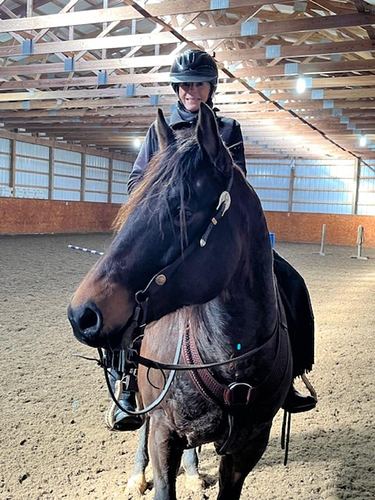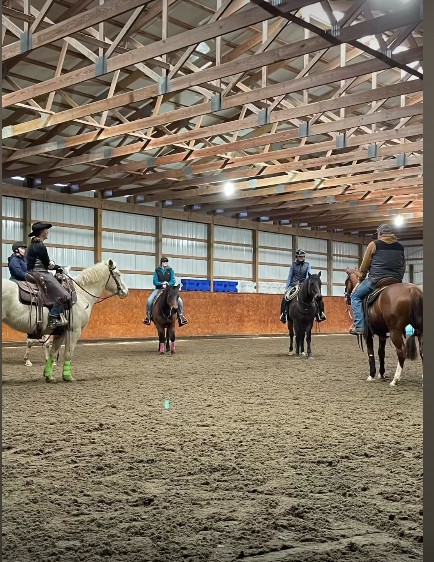The clinic was supposed to be 5 people, but only 4 were there mounted and two auditors. Everyone mounted had a horse that had a solid foundation --however, only Bob and I had been riding regularly all winter. The organizer told the clinician (professional reining rider) about Bob, me, and my trainer --I wasn’t going to mention it, but didn’t seem to matter. The clinician, Corey Wilson, knew my trainer’s boss and thought highly of him as a rider, judge, and trainer. He had seen my trainer (the assistant to the big cheese) ride and said he’d heard only good things about her --like me, her other clients thought she communicated well and had a good basis of knowledge. [Good to hear!]
Our clinic began with asking each rider what she wanted to accomplish today --I said improve transitions, others wanted to work on spins and neck reining. Only one other rider was riding with a curb bit (Bob uses a low port short shanked bit that has a name but I don’t remember it). The other two horses had snaffles, despite being well over the age where snaffles are allowed. One rider was a professional (buying horses, training them, selling, and giving lessons). The other was hoping to show AQHA Ranch Horse (big time Ranch Horse) and the 4th just wanted to improve her riding. We began by warming up at the trot, then individually doing cantered circles stressing roundness of the circles and keeping the horse “soft in the bridle.” Bob (or I) was tense at the start, but after awhile, both of us relaxed and were doing better circles, keeping our nose (or his nose) tipped in.
There was a lunch break where the clinician told some good reining stories (horses completing winning patterns after bridles came off (touching the ground would have been DQ but the riders were astute enough to hold the broken leather off the ground and continue their rides to score). He said that the top reining riders train the best reining horses bred specifically for reining. He said that if we put the best reining rider on one of our horses, he would (likely) struggle with the same things we do as our horses are not bred for the sport (Bob is Hancock and 2Eyed Jack --a cutting/cow bred horse). He said some professionals ride over 20 horses a day, but have people who saddle, bridle and warm up the horse, then the professional will work on one aspect for 20-30 min and achieve the goal, then move on to the next horse while someone else untacks and cools the horse.
The clinician suggested to the snaffle riders that they consider moving to curb --and said a specific kind but not sure what it was. After lunch one did so --she had a second bridle in her trailer. The afternoon secession was obstacles – Bob was in his element --he opened gates, side passed, backed, and cantered off on the correct lead each time (proud of m’boy!). Then came the focus on spins —just to be clear --Bob is 10 (well, he will be in November) --I have never cued a spin, and as far as I know, Bob has never been asked to spin. A fast spin is not expected in Ranch Horse classes --but it should be correctly done (plant hind foot, cross front feet until a 360 is achieved) . I waited my turn as the clinician worked with the first horse who did a great spin – he gave a few suggestions --then moved to the second and third horse who were respectable – then me –
I explained my lack of knowledge and Bob’s lack of training --but the clinician said, ok, just trot in a circle --then he had us make it smaller and smaller and BOB WAS SPINNING! Turns out I might have been wrong about Bob never having been trained to do a spin! Bob did a respectable spin both ways, fast enough that I was dizzy! – After twice each way, we called it good.
By then the afternoon had flown by --one other thing to address --in Ranch Horse Trail Class, the last obstacle is “load horse into a trailer.” Gulp. Bob self loads 19/20 times --until he doesn’t. He always loads eventually, he just doesn’t do it smoothly that one time out of 20. And yes, I’ve tried everything you can think of —so, I explained that to the clinician who pointed out, Bob does a lot of things well and he DOES load 19 out of 20 times.
After the clinic --I said (half in jest) “Do you want to watch Bob not load?” --he said, “Sure,” and walked with us to my trailer.
Bob started to self-load beautifully --then changed his mind and backed out. The clinician took my lead rope and handy stick and corrected Bob’s behavior far more smartly than I EVER did. It only took once and Bob immediately loaded perfectly. Ok --I’m a wimp --didn’t want to hurt my horse even though he was being disrespectful not only of my cue, but my space. Lesson learned. Grow a spine (actually, someone on COTH has said that to me a few times).
The lovely indoor --the nice people, and the good clinician made the day well worthwhile.
Bob and me at the clinic:
Another picture






 I enjoyed reading your report.
I enjoyed reading your report.
 ) He’s so good minded and willing to be a good boy. Cow work,reining, he’s up to everything, he reminds me a lot of my good old Ciri, always ready for a new adventure and always trying his best.
) He’s so good minded and willing to be a good boy. Cow work,reining, he’s up to everything, he reminds me a lot of my good old Ciri, always ready for a new adventure and always trying his best.